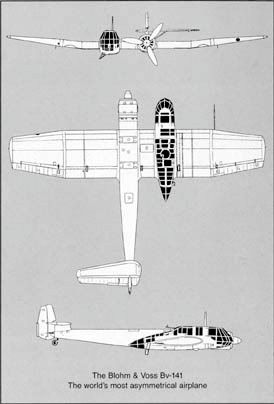
The story of the poor, deformed Bv-141 began in the late 1930s when the Luftwaffe was shopping for a light ground attack aircraft to supplement the Junkers Ju-87 Stuka, which was already in production. Focke Wulf proposed its Fw-189, while at Blohm & Voss, designer Richard Vogt came up with what is certainly the most asymmetrical airplane ever flown.
It would have been intriguing to know what Vogt had in mind when he conceived her, as it would be interesting to know what charisma he must have brought into play in order to convince his employers to take such a design to the Reich Luftfarhtsministerium (Air Ministry). In any case, the RLM was predictably appalled by this strange contrivance and refused to appropriate a single pfenning for its production. There were scowls and snickering and suggestions that Blohm & Voss stick to flying boats. Focke Wulf's Fw-189 won the production contract.
Blohm & Voss was, however, sufficiently impressed with the Bv-141, that they actually undertook to build it at their own expense. The airplane that emerged from Vogt's drawings was remarkably aerodynamic, the fact of which he'd already known. It was 39 feet 10 inches long, with a wingspan of 50 feet 8 inches and a weight of 8600 pounds, putting it in almost exactly the same size and weight class as the familiar Messerschmitt Bf-110. Powered by a BMW132 865 hp radial engine, the Bv-141 had a respectable top speed of 248 mph and a ceiling of 29,530 feet, while its 700-mile range was almost twice that of the Fw-189.
Its first flight, on 25 February 1938, proved the Bv-141 to be more airworthy than its detractors wanted to believe. Over the next two years three prototypes and 10 Bv-141A production aircraft were completed, but the poor bird never shook the stigma of its disfigured appearance.